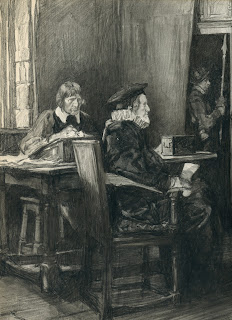But Gruger's "famous technique" wasn't all that secret. Essentially he used pencil on cardboard. Sometimes he supplemented it with a little wash. His only protection against imitators was his talent.
Gruger drew on a cheap board that he discovered when he first started out on the staff of a newspaper art department. Newspaper printers used thin cardboard, called "railroad blank," as a backing for silverprints. Gruger found stacks of the stuff lying around, and nobody cared how much he used. He discovered that the soft surface took his pencil well, and he soon began experimenting with an eraser and smearing carbon for special effects. The board later became famous as "Gruger board," in recognition of the miracles that Gruger was able to perform on it. But many wonderful Gruger originals are no longer with us today because the treacherous Gruger board was so flimsy.
The artist began an illustration with a light pencil drawing on the cardboard. He would sometimes go over this preliminary drawing with a wash made from black watercolor, to block out his tonal composition. Then he followed up with pencils, starting with a hard pencil and finishing up with a Wolff carbon pencil which produced a "rich, velvety black" that was so often lost in the reproduction process.
Let's see how this approach worked in some close ups from another Gruger original:
 |
| “The King’s Minion” by Rafael Sabatini, American Magazine, September 1930 |
Note how Gruger draws important faces in relatively sharp focus, but then quickly drops back as he pulls away from those focal points. He indicates surrounding elements such as hands in softer terms so they don't compete with the faces:
 |
| Gruger deliberately went back and smudged this hand with an eraser. |
By the time Gruger gets to background figures, they are mostly just shapes added for compositional purposes.
 |
| No fingernails here: these hands are a lovely little abstraction. |
But for me, the most impressive thing about the way Gruger prioritized his drawing was his control over the value scale.
That's why it's such a shame that most people only know Gruger for the etiolated images on the inner pages of old magazines.
Gruger drew on cheap board which is already crumbling around the edges, and his completed work was printed on cheap magazine paper which robbed his drawings of their dark and light accents. Sandwiched between these two limitations, Gruger nevertheless put his heart and talent into 6,000 carbon illustrations. Before his original marks disappear altogether, they deserve an appropriate audience.

















